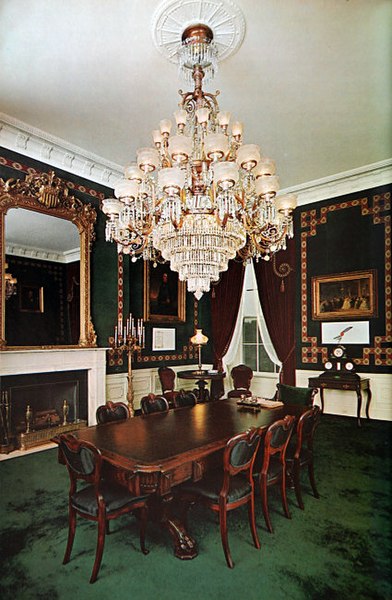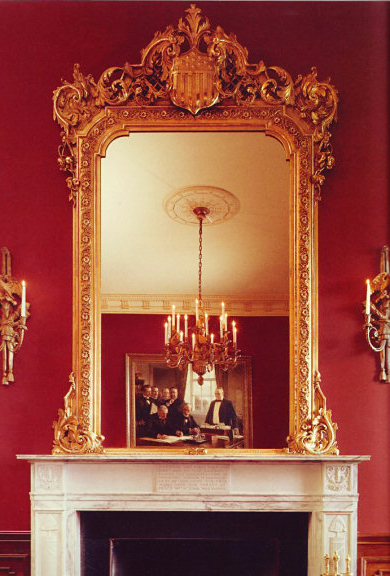 |
| Treaty Room, Kennedy Administration, with Grant's table. Public Domain |
President Lincoln used this particular room as a waiting room for the Presidential Office next door (which is now the Lincoln Bedroom). After Lincoln's assassination, his successor, President Johnson, chose to use the chamber as a meeting place for the Cabinet.
The Cabinet continued to meet here during subsequent administrations, and in 1869, President Ulysses S. Grant ordered a large walnut conference table with overstuffed chairs for the Cabinet to use. The table is fitted with eight locking drawers, which meant President Grant and each of the seven members of Cabinet had his own drawer in which to store things.
 |
| The Cabinet Room, 1901, using Grant's Cabinet Table. Public Domain. |
 |
| President Obama in the Treaty Room, using the Grant Table as a desk. In the background, note Theobald Chartran's painting "Signing of the Peace Protocol Between Spain and the United States, August 12, 1898." Public Domain. |
For the next several years, the room served various purposes, but it became known as the Monroe Room during the Hoover Administration when First Lady Lou Hoover turned it into a parlor using furnishings from the Monroe Administration, including the desk on which Monroe signed the Monroe Doctrine. The Truman Administration, however, redecorated using contemporary pieces.
In 1961, Jacqueline Kennedy oversaw the redecoration of the room, so that it closer resembled the Cabinet Room of Grant's administration almost a hundred years before. President Grant's conference table was returned, and the walls were papered in dark green, in a pattern similar to the paper in the room at the Peterson House (across the street from Ford's Theater) where Abraham Lincoln died. Theobald Chartran's painting "Signing of the Peace Protocol Between Spain and the United States, August 12, 1898" was hung in the room, as were copies of several treaties signed at the White House--and the name Treaty Room was chosen for the chamber.
President Kennedy signed the Nuclear Test Ban Treaty in the room in 1963, and President Nixon signed the US instrument of ratification of the Treaty on the Limitation of Anti-Ballistic Missile Systems in 1972.
 |
| President Kennedy signing the Limited Nuclear Test Ban Treaty, October 7, 1963, in the Treaty Room (but not using the Grant table). Robert L. Knudson. Public Domain. |
In 1993, the Treaty Room was decorated in rich colors and used as a private office for President Clinton. The walls were papered in simulation red-leather-style paper, and a gilded walnut chandelier that once hung in the Red Room was installed.
 |
| Treaty Room, Clinton Administration. Note the Theobald Chartran painting reflected in the mirror. Public Domain. |
 |
| President Bush in the Treaty Room, with his feet on the Grant Cabinet Table, in 2001. White House Museum. Public Domain. |
While often overlooked among other, more famous chambers in the White House, the Treaty Room has been a place of incredible importance. Throughout the decades, policy was debated in this room, armistices negotiated, and treaties signed. One can only imagine what the walls would say if they could talk!
***
 Susanne Dietze began writing love stories in high school, casting her friends in the starring roles. Today, she's the Selah award-winning author of over a dozen historical romances who's seen her work on the ECPA, Publisher's Weekly, and Amazon Bestseller Lists for Inspirational Fiction. Married to a pastor and the mom of two, Susanne lives in California and enjoys fancy-schmancy tea parties, genealogy, the beach, and curling up on the couch with a costume drama and a plate of nachos. You can visit her on her website, www.susannedietze.com
Susanne Dietze began writing love stories in high school, casting her friends in the starring roles. Today, she's the Selah award-winning author of over a dozen historical romances who's seen her work on the ECPA, Publisher's Weekly, and Amazon Bestseller Lists for Inspirational Fiction. Married to a pastor and the mom of two, Susanne lives in California and enjoys fancy-schmancy tea parties, genealogy, the beach, and curling up on the couch with a costume drama and a plate of nachos. You can visit her on her website, www.susannedietze.com

I love these posts. Thank you for telling us the history of these special rooms. If walls could talk, indeed!
ReplyDeleteI am so glad you're enjoying them, Connie! I, too, have enjoyed learning about the history of different rooms in the White House. Thanks for coming by!
ReplyDeleteGreat post! Thanks for sharing.
ReplyDeleteThanks, Connie! I appreciate you visiting. Hope you're having a great weekend!
DeleteTremendously entertaining post, Susie. I think of all the decors, I like the Kennedy's green color scheme with Grant's table as the one that looks the most impressive. I can certainly imagine treaties being signed in such a place and it would stick in the mind of those attending such an occasion as well.
ReplyDeleteI'd never heard of a table with individual locking drawers and I must say, that stirs my imagination. :)
Thanks for introducing me to the Treaty Room.